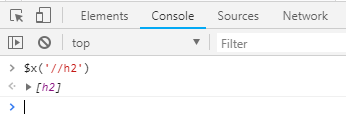本文实例讲述了Python爬虫框架Scrapy基本用法。分享给大家供大家参考,具体如下:
Xpath
<html> <head> <title>标题</title> </head> <body> <h3>二级标题</h3> <p>爬虫1</p> <p>爬虫2</p> </body> </html>
在上述html代码中,我要获取h3的内容,我们可以使用以下代码进行获取:
info = response.xpath("/html/body/h3/text()")
可以看出/html/body/h3为内容的层次结构,text()则是获取h3标签的内容。//p获取所有p标签。获取带具体属性的标签://标签[@属性="属性值"]
<div class="hide"></div>
获取class为hide的div标签
div[@class="hide"]
再比如,我们在谷歌Chrome浏览器上的Console界面使用$x['//h3']命令获取页面中的h3元素信息:

xmlfeed模板
创建一个xmlfeed模板的爬虫
scrapy genspider -t xmlfeed abc iqianyue.com
核心代码:
from scrapy.spiders import XMLFeedSpider
class AbcSpider(XMLFeedSpider):
name = 'abc'
start_urls = ['http://yum.iqianyue.com/weisuenbook/pyspd/part12/test.xml']
iterator = 'iternodes' # 迭代器,默认为iternodes,是一个基于正则表达式的高性能迭代器。除了iternodes,还有“html”和“xml”
itertag = 'person' # 设置从哪个节点(标签)开始迭代
# parse_node会在节点与提供的标签名相符时自动调用
def parse_node(self, response, selector):
i = {}
xpath = "/person/email/text()"
info = selector.xpath(xpath).extract()
print(info)
return i
csvfeed模板
创建一个csvfeed模板的爬虫
scrapy genspider -t csvfeed csvspider iqianyue.com
核心代码
from scrapy.spiders import CSVFeedSpider
class CsvspiderSpider(CSVFeedSpider):
name = 'csvspider'
allowed_domains = ['iqianyue.com']
start_urls = ['http://yum.iqianyue.com/weisuenbook/pyspd/part12/mydata.csv']
# headers 主要存放csv文件中包含的用于提取字段的信息列表
headers = ['name', 'sex', 'addr', 'email']
# delimiter 字段之间的间隔
delimiter = ','
def parse_row(self, response, row):
i = {}
name = row["name"]
sex = row["sex"]
addr = row["addr"]
email = row["email"]
print(name,sex,addr,email)
#i['url'] = row['url']
#i['name'] = row['name']
#i['description'] = row['description']
return i
crawlfeed模板
创建一个crawlfeed模板的爬虫
scrapy genspider -t crawlfeed crawlspider sohu.com
核心代码
class CrawlspiderSpider(CrawlSpider):
name = 'crawlspider'
allowed_domains = ['sohu.com']
start_urls = ['http://sohu.com/']
rules = (
Rule(LinkExtractor(allow=r'Items/'), callback='parse_item', follow=True),
)
def parse_item(self, response):
i = {}
#i['domain_id'] = response.xpath('//input[@id="sid"]/@value').extract()
#i['name'] = response.xpath('//div[@id="name"]').extract()
#i['description'] = response.xpath('//div[@id="description"]').extract()
return i
上面代码rules部分中的LinkExtractor为连接提取器。
LinkExtractor中对应的参数及含义
| 参数名 | 参数含义 |
|---|---|
| allow | 提取符合正则表达式的链接 |
| deny | 不提取符合正则表达式的链接 |
| restrict_xpaths | 使用XPath表达式与allow共同作用提取同时符合对应XPath表达式和对应正则表达式的链接 |
| allow_domains | 允许提取的域名,比如我们想只提取某个域名下的链接时会用到 |
| deny_domains | 进制提取的域名 |
更多关于Python相关内容可查看本站专题:《Python Socket编程技巧总结》、《Python正则表达式用法总结》、《Python数据结构与算法教程》、《Python函数使用技巧总结》、《Python字符串操作技巧汇总》、《Python入门与进阶经典教程》及《Python文件与目录操作技巧汇总》
希望本文所述对大家Python程序设计有所帮助。
免责声明:本站发布的内容(图片、视频和文字)以原创、转载和分享为主,文章观点不代表本网站立场,如果涉及侵权请联系站长邮箱:is@yisu.com进行举报,并提供相关证据,一经查实,将立刻删除涉嫌侵权内容。